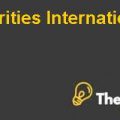INTRODUCTION
The national and international business has become more complex, uncertain and fast-moving than ever before. The organizational working environment on the global platform is changing rapidly, which leads the company to face multiple challenges and issues such as cultural differences, diversification issues, discrimination and the inflexible working environment. Cultural diversity is one of the biggest and important challenges that different organizations face nowadays. Moreover, the cultural diversity in the workplace means the business is becoming heterogeneous in terms of age, ethnic background, knowledge, sexual orientation, and nationality (TM Amabile, 1996).
HIGH AND LOW CONTEXT CULTURE
According to Dr. Edward Hall, the culture is divided into two general categories such as high-context culture and low context culture. In the high context culture, communication mainly lies in the physical context that includes facial expressions, postures, gestures and tone of voice. However, the message conveyed itself carries less information because people do not explicitly say what they want to express. Moreover, the members of the high cultural context, such as family or societies have mutual and close relationships for a long period. As a result, the members know how to think, how to behave, and what are the rules and regulations (D Kim, 1998).
On the other hand, in the low context culture, communication lies on the verbal communication and communicators are expected to be efficient, effective, straightforward, and concise in delivering the message. Moreover, members of a low-context culture are considered as linear, logical, individualistic and task-oriented. Furthermore, the people have connections for a shorter period and the information is specific and transparent. Apart from that, a solving problem in the workplace means adding facts, figures and evaluating one after another.
HIGH-CONTEXT COUNTRY
The High-context countries include China, Japan, France, Russia, India, Mexico, and Brazil. The people from high-context culture prefer collectivism and group harmony rather than individualism. Moreover, the people are relation-oriented, intuitive, and contemplative and emphasize interpersonal relationships. Furthermore, developing trust and diversity is one of the important steps in any business transactions. However, the high-context also comprises of many disadvantages such as lack of diversity in the workplace, women and power distance discrimination, indirect communications, conflicts among employees, and lack of transparency in delivering information (EG Chua, 1987).
In China, the flow of communication is effective and efficient because of their information flow at work and in privacy. Moreover, in decision-making , they discuss everything in advance and do not prefer to conduct an official meeting because the detailed and excessive discussion is considered as an insult in France and some Asian Countries. In comparison, Japanese find western countries as offensive and on the other hand, western countries feel Japanese as secretive and devious. However, some challenges and issues arise in the workplace when people of different cultural context interact with each other (Gudykunst, 1983).
INTERVIEW
According to the Liam Christopher, the general manager in the high-culture context company, employees at the workplace should build a good relationship with their colleagues and communicate intensively with each other. Moreover, the employees should work effectively as a team and help the company to increase its productivity and profitability in the long run. Furthermore, employees tend to be reserved that is considered as an active behavior in collective culture. However, indirect and lack of verbal communication lead the company to face multiple issues such as lack of diversity and conflicts among the employees and as a result, decrease in trust and confidence. Furthermore, the departments of high-context culture include Human resource, research and development, manufacturing and procurement, and marketing department.Cultural Differences Case Solution
CULTURE DIFFERENCE IN THE WORKPLACE
The cultural differences in the workplace give rise to various problems and issues such as miscommunication, unethical standards, downsizing, high competition, high absenteeism rate and trust issues. Moreover, the issues at the workplace include discrimination, stereotypes, ethnocentrism, prejudices, and diversity. In high-context, countries are given minimum business opportunities to the women and not considered to be in the top position. Furthermore, it is difficult to enter in a high - context culture for the low-context individual because of resistance in building a close relationship, power distance, believes in collectivism and masculinity and unwritten rules and regulations in the workplace (P Lok, 2004).
On the other hand, it is comparatively difficult for a stranger to enter in low-context culture because the work environment contains much information you need to participate. Moreover, a person prefers to accomplish the task rather than building a long-term relationship. Therefore, it is important for the company to initiate an ethical leadership approach in the workplace to produce innovative and diverse organizational culture (ME Brown, 2006).................
This is just a sample partial case solution. Please place the order on the website to order your own originally done case solution.













